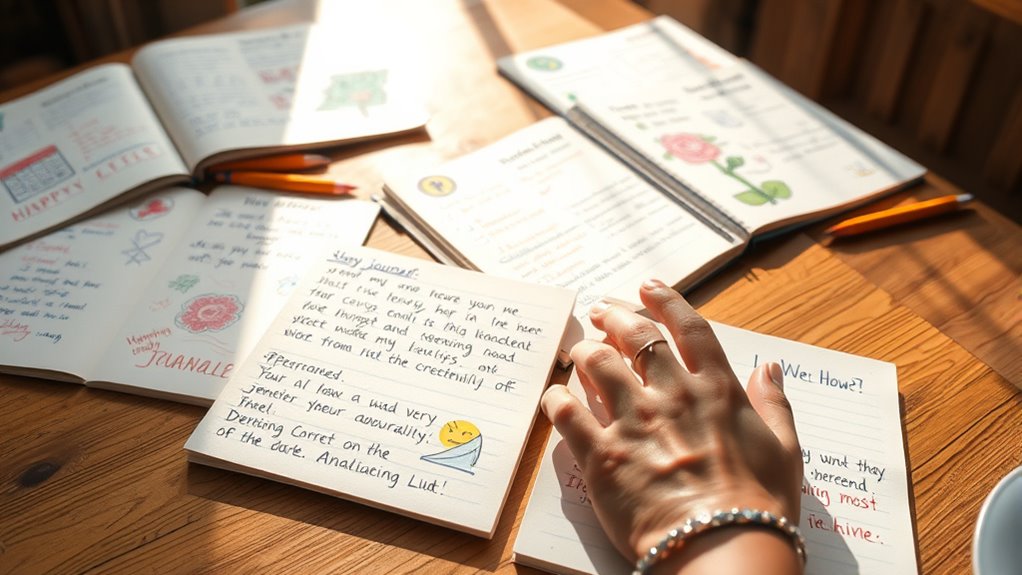Guided journaling prompts for memory care focus on encouraging reflection, recall, and emotional expression. You can use prompts like favorite childhood memories, special family traditions, or moments of happiness to help evoke memories and foster connection. Incorporating sensory cues, visual aids, and a supportive environment makes journaling more engaging and meaningful. If you keep exploring, you’ll find effective techniques and ideas to make journaling a rewarding part of memory care.
Key Takeaways
- Use familiar topics like childhood memories, family traditions, or joyful experiences to evoke positive reflections.
- Incorporate sensory cues such as scents, textures, or visuals to trigger memory recall during journaling.
- Provide simple, structured prompts that encourage emotional expression and personal storytelling.
- Include visual aids like photos or drawings to enhance engagement and support memory retrieval.
- Create a calm, inviting environment with soothing lighting and minimal distractions to foster focused reflection.
Benefits of Journaling in Memory Care Settings

Journaling offers numerous benefits in memory care settings by providing residents with a meaningful way to express themselves. It promotes memory enhancement by encouraging residents to recall past experiences, which can strengthen neural connections and improve cognitive function. Additionally, journaling supports emotional well-being by offering a safe outlet for feelings and thoughts, reducing stress and anxiety. As residents put their memories into words, they often experience a sense of accomplishment and connection, fostering a positive mood. This activity also helps maintain a sense of identity and personal history, which is vital in memory care. Incorporating mental clarity exercises like journaling can further boost cognitive resilience and overall well-being. Overall, engaging in journaling can be a powerful tool to boost mental clarity and emotional stability, enriching residents’ daily lives and promoting holistic health.
Types of Prompts to Encourage Reflection and Recall

You can use memory recall triggers like familiar scents or songs to spark memories. Personal reflection topics encourage you to share feelings or past experiences, making journaling more meaningful. Combining these prompts helps foster connection and stimulates your memory effectively. Incorporating color accuracy considerations can also enhance visual clarity and emotional impact during your reflection.
Memory Recall Triggers
Memory recall triggers are powerful tools that can help spark memories and encourage reflection in individuals with memory care needs. Using mnemonic devices, like rhymes or acronyms, helps connect new information to familiar cues. Sensory stimulation also plays a vital role; scents, sounds, textures, or visuals can evoke strong memories. For example, a familiar song might bring back a special moment, or the scent of baked bread might remind someone of childhood. To illustrate, here’s a table of common triggers:
| Sensory Stimuli | Mnemonic Devices | Daily Life Examples |
|---|---|---|
| Smell | Acronyms | Baking bread, perfume |
| Sound | Rhymes | Favorite songs, voices |
| Touch | Memory cues | Textured fabrics, blankets |
| Sight | Visual cues | Family photos, landscapes |
| Taste | Mnemonics | Favorite foods, teas |
Additionally, incorporating mindfulness techniques can enhance the effectiveness of memory recall exercises by promoting present-moment awareness.
Personal Reflection Topics
Personal reflection prompts are essential tools that encourage individuals to explore their memories and experiences deeply. They help evoke memory triggers and promote emotional expression, making recollections more vivid. When choosing topics, focus on prompts that connect with personal history and feelings. Here are some effective ideas:
- Describe a favorite childhood memory and what made it special.
- Recall a time when you felt truly happy and what contributed to that emotion.
- Share a meaningful tradition or family story that has stayed with you.
- Consider how understanding emotional regulation has influenced your approach to personal memories and relationships.
These prompts stimulate emotional expression and activate memory triggers, helping individuals reconnect with their past in a meaningful way. Personal reflection topics like these foster self-awareness and can bring comfort and joy through shared memories.
Creating a Supportive Environment for Journaling Activities

You can help by setting up comfortable writing spaces that make journaling inviting and calming. Keep the area free of distractions to help focus and reduce frustration. A quiet, cozy spot encourages your loved ones to engage more confidently in their journaling activities. Incorporating sensory toys into the environment can also enhance sensory engagement and create a more enriching experience.
Comfortable Writing Spaces
Creating a comfortable writing space is essential for encouraging meaningful journaling activities. When the environment feels inviting, your loved one is more likely to engage and express themselves. Focus on creating a calming atmosphere with soothing lighting that isn’t too harsh or bright. Choose comfortable seating that supports good posture and feels cozy. To enhance the space, consider these elements:
- Use soft, warm lighting to reduce glare and create a relaxing mood
- Provide cushioned, supportive chairs or cushions for comfort
- Keep the area tidy and free of clutter to promote focus and ease
- Incorporate aromatic herbs or essential oils to create a calming sensory environment that can enhance relaxation during journaling
These small adjustments help foster a supportive environment, making journaling a pleasant and accessible activity for memory care.
Minimizing Distractions
Minimizing distractions is key to helping your loved one focus and enjoy journaling. Reducing noise through quiet spaces or soft background sounds creates a calm environment that encourages concentration. Turn off TVs, radios, and any devices that might cause interruptions. Good noise reduction helps prevent confusion or frustration. Additionally, managing time effectively ensures journaling sessions stay brief and engaging, preventing fatigue or boredom. Set aside specific times when your loved one is most alert, and keep sessions consistent to build a routine. Keeping the environment free of clutter and distractions allows your loved one to settle into the activity comfortably. Using sound masking techniques can further enhance the peaceful atmosphere. By managing noise and time wisely, you create a supportive space where journaling becomes a meaningful, peaceful experience.
Techniques for Introducing Journaling to Individuals With Memory Challenges

Introducing journaling to individuals with memory challenges requires patience and a thoughtful approach. To encourage participation, start with simple, familiar topics that promote emotional expression. Here are three effective techniques:
- Use prompts that evoke positive memories, making creative writing easier and more meaningful.
- Incorporate gentle reminders and cues, such as photos or objects, to stimulate memories and spark ideas.
- Offer encouragement and celebrate small successes to build confidence and foster a sense of accomplishment.
- Utilize diverse designs and materials to create engaging and personalized journaling tools that resonate with individuals’ preferences and enhance their experience.
Incorporating Visual and Sensory Elements Into Journaling

Adding visual and sensory elements to journaling can substantially enhance engagement for individuals with memory challenges. Incorporate visual aids like photographs, drawings, or colorful images to trigger memories and encourage expression. Sensory prompts, such as textured materials, fragrant objects, or soothing sounds, invite your loved one to connect with their senses. These elements help make journaling more accessible and stimulating, especially for those who struggle with traditional writing. By providing visual cues and tactile experiences, you create a richer, more inviting environment that supports memory recall and emotional connection. Use simple, familiar items to spark interest and make the process enjoyable. Incorporating sensory stimulation can further deepen engagement and foster a more meaningful journaling experience.
Sharing and Celebrating Journaling Achievements

Celebrating journaling achievements can remarkably boost your loved one’s confidence and motivation. Sharing success stories and celebrating milestones encourages a sense of pride and accomplishment. When you highlight their progress, it reinforces positive feelings and helps maintain engagement. Here are some ways to do this:
- Share successes with family and friends to create a supportive environment.
- Celebrate milestones by acknowledging specific achievements, like completing a journal page or recalling a memory.
- Display journal entries in visible areas to remind your loved one of their progress and boost self-esteem.
- Incorporate motivational reinforcement techniques to further encourage continued journaling and participation.
These actions turn journaling into a meaningful activity, fostering a sense of achievement and joy while emphasizing the importance of their memory journey.
Tips for Caregivers to Sustain Engagement and Motivation

Recognizing your loved one’s journaling achievements can motivate them to continue, but maintaining their engagement over time requires ongoing effort. Use motivational strategies like setting small, achievable goals and celebrating progress to keep their spirits high. Regularly change prompts to keep journaling fresh and interesting, preventing boredom. Remember, your own caregiver self care is essential; taking breaks helps you stay patient and enthusiastic. Encourage a routine but remain flexible to adapt to their changing needs. Offer gentle reminders without pressure, and always acknowledge their efforts, no matter how small. Staying positive and supportive helps sustain motivation, making journaling a rewarding activity for both of you. By balancing encouragement with self-care, you create a nurturing environment that promotes continued engagement.
Frequently Asked Questions
How Can Journaling Be Adapted for Severe Memory Impairments?
When adapting journaling for severe memory impairments, you should focus on providing memory cues and using simplified prompts. This helps trigger memories and makes the activity less overwhelming. Keep prompts short, clear, and concrete, encouraging participation without frustration. Use visual aids or familiar objects to support memory cues. This way, you create a supportive environment that promotes engagement and preserves a sense of identity through accessible, tailored journaling activities.
What Safety Precautions Should Be Taken During Journaling Activities?
When you facilitate journaling, prioritize safety by ensuring fire safety measures are in place, such as no open flames and accessible exits. Respect privacy concerns by providing a secure, private space and explaining confidentiality. Supervise the activity to prevent accidents, and use non-toxic, safe materials. Always monitor for any signs of distress and be prepared to assist, creating a safe, respectful environment for everyone involved.
Are There Specific Materials Recommended for Individuals With Memory Loss?
Imagine your journaling session as planting a garden of memories. You should choose simple, sturdy materials like thick, textured paper and easy-to-hold pens to serve as memory aids. Sensory tools like scented markers or soft fabrics can stimulate senses and enhance engagement. These thoughtful choices help individuals with memory loss connect more comfortably and confidently, making their journaling experience both meaningful and accessible.
How Can Technology Support Journaling in Memory Care?
Technology can greatly support journaling in memory care by offering digital tools and assistive devices that make writing easier and more engaging. You can introduce tablets with specialized apps that allow voice-to-text features or simplified interfaces, helping individuals express their thoughts without frustration. These tools encourage independence, preserve memories, and provide a safe, accessible way for residents to engage in journaling, fostering emotional well-being and cognitive connection.
What Are Common Challenges Caregivers Face When Implementing Journaling?
Imagine trying to plant a garden with rocks in the soil—that’s how emotional resistance can feel when you start journaling with memory care clients. You may struggle with their reluctance or forgetfulness, which adds to your caregiver burnout. Common challenges include overcoming emotional resistance, maintaining consistency, and finding time. Yet, with patience and support, you can help clients express themselves, easing your workload and enriching their lives.
Conclusion
Think of journaling as planting seeds in a garden of memories. Each prompt nurtures growth, even amid fading recollections. As you support and celebrate these moments, you help your loved one’s inner landscape flourish, transforming fleeting thoughts into a vibrant tapestry. With patience and care, you become the gentle gardener guiding them through this sacred process—where every word blossoms into a lasting symbol of identity, hope, and connection.









